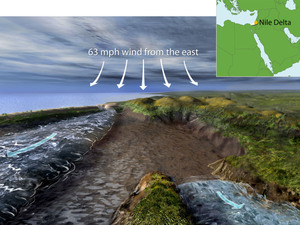 Carl Drews, a software engineer studying a weather phenomenon known as “wind set-down” has used a computer model to simulate how Moses may have witnessed the “parting of the sea” on his exodus out of Egypt.
Carl Drews, a software engineer studying a weather phenomenon known as “wind set-down” has used a computer model to simulate how Moses may have witnessed the “parting of the sea” on his exodus out of Egypt.
Moses is an important religious figure in Judaism, Christianity and Islam, too. Now science has provided a convincing theory for the rest of us, as to how Moses was able to lead the Hebrew people out of Egypt and across the Red Sea.
The biblical account describes high winds gusting through the night prior to the escape route being uncovered. Drews matches the descriptions of the local geography to come up with a computer model that resulted in the “miracle” being readily duplicated.
Drews and the researchers at the National Center for Atmospheric Research (NCAR) and the University of Colorado at Boulder showed how sustained winds can cause an event known as a wind setdown, in which water levels are temporarily lowered. A strong east wind over the Nile Delta could have pushed water back into ancient waterways after blowing for about nine hours, exposing mud flats at a bend where a river is believed to have merged with a coastal lagoon along the Mediterranean Sea. (See the animation below)
“The Exodus account describes Moses and the fleeing Israelites trapped between the Pharaoh’s advancing chariots and a body of water that has been variously translated as the Red Sea or the Sea of Reeds,” says a report about the study by NCAR. “In a divine miracle, the account continues, a mighty east wind blows all night, splitting the waters and leaving a passage of dry land with walls of water on both sides. The Israelites are able to flee to the other shore. But when the Pharaoh’s army attempts to pursue them in the morning, the waters rush back and drown the soldiers.”
“The simulations match fairly closely with the account in Exodus,” says Drews. “The parting of the waters can be understood through fluid dynamics. The wind moves the water in a way that’s in accordance with physical laws, creating a safe passage with water on two sides and then abruptly allowing the water to rush back in.”
Wind setdowns, which are the opposite of storm surges, have been widely documented, including an event in the Nile delta itself in the 19th century when a military commander reported a powerful wind pushing away about five feet of water, exposing dry land.
The research is published in the online journal, PLoS ONE and is part of Drews’s master’s thesis in atmospheric and oceanic sciences. By pinpointing a possible site south of the Mediterranean Sea for a potential Red Sea crossing, the study also could be of benefit to archeologists seeking to research whether such an event more than 3,000 years ago ever took place.
(Visualization by Tim Scheitlin and Ryan McVeigh, NCAR; based on model simulations. Read more at NCAR)



















